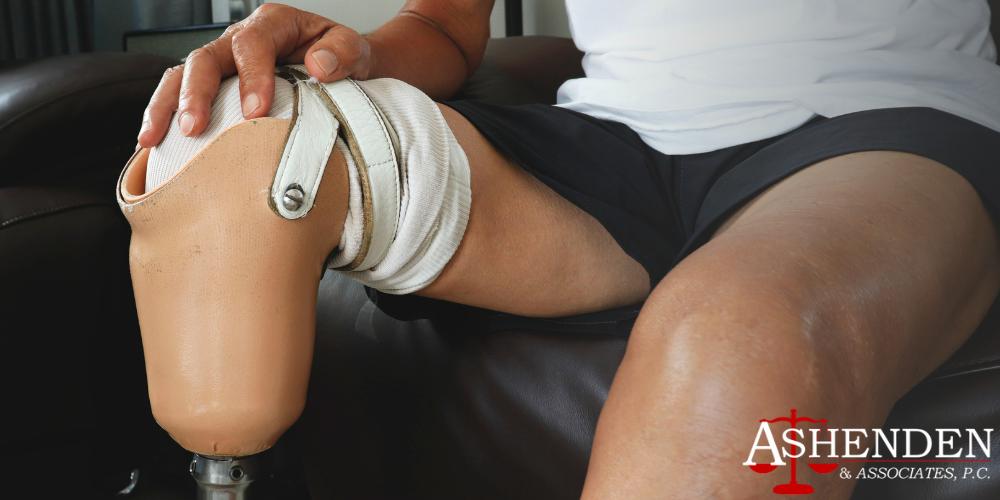We Go The Extra Distance For Our Clients
Home » Personal Injury » Amputation Injury
Practice Areas
Sandy Springs Amputation Lawyer
Accidents or injuries that lead to amputation may not be common, but the effects can be devastating. Amputation injuries can cause mental, physical, and financial hardship through the trauma, pain, and medical expenses related to those incidents. Amputation victims can be left with permanent disabilities and may even have to re-learn basic life functions such as eating and walking. If you have been a victim of partial or complete amputation due to negligence, a Sandy Springs amputation lawyer at Ashenden & Associates are here to help you recover financial compensation for your suffering. Call 770-394-8909 to schedule a free consultation with our legal team today.

What is an Amputation?
Amputation occurs when a person’s limb is either partially or completely severed from their body. A traumatic amputation occurs when someone experiences amputation as a result of a catastrophic injury. These could potentially be caused by someone else’s negligence, such as a lack of occupational safety precautions. Surgical amputation occurs in the case of extreme health complications in which doctors need to remove a particular body part to save the patient’s life. Amputation may be necessary when the patient is suffering from an advanced infection or a cancerous tumor in their extremities. Vascular diseases may also cause this kind of amputation.
Regardless of how the amputation occurred, patients will require serious medical attention and may be referred to a physical therapist. Those who suffer from traumatic amputations may also need mental health counseling. While amputation injuries can be more than inconveniencing, the loss of limb doesn’t necessarily mean loss of all function. Prosthetic limbs can help the remaining part or parts of the limb, also called the residual limb, regain some function.
How Common Are Amputations in the U.S.?
According to a study done in 2005, 1.6 million residents of the United States were living without a limb at the time, including cases of congenital limb loss. The same study estimated that the number would more than double by 2050, potentially totaling 3.6 million.
If you are one of the more than one million Americans suffering from the loss of a limb and your amputation was the result of negligence, you may need an Sandy Springs amputation injury attorney. The lawyers at Ashenden & Associates have tried many personal injury cases, including amputation injury cases. We can help you recover damages including compensation for pre-existing or future medical bills. Call us at (770) 394-8909 so we can provide you with a skilled amputation attorney and help try your case.

Commonly Amputated Body Parts
Limb injury involving extreme damage to bone or soft tissue will often end in amputation, and limb amputation can occur in many different parts of the body. Upper extremity amputations may include:
- Partial hand amputation, also known as metacarpal amputation or finger amputation;
- Wrist disarticulation, or the removal of the entire hand;
- Transradial amputation, or the removal of the arm below the elbow;
- Elbow disarticulation, or the removal of the entire forearm;
- Transhumeral amputation, or the removal of the arm above the elbow;
- Shoulder disarticulation, or the removal of the entire arm; and
- Forequarter amputation, or the removal of the arm and part of the shoulder.
Limb loss can also occur in the lower half of the body. Lower extremity amputations include:
- Partial foot amputation, which includes the removal of toes or other parts of the foot;
- Ankle disarticulation, or removal of the entire foot;
- Transtibial amputation, or removal of the leg below the knee;
- Knee disarticulation, or the removal of the entire lower leg;
- Transfemoral amputation, or the removal of the leg above the knee;
- Hip disarticulation, or the removal of the entire leg; and
- Pelvic amputation, which is the removal of the entire leg as well as part of the pelvis.

Common Causes of Amputations
Amputation could occur as a result of a vascular disease, a cancerous tumor, or an advanced infection in the extremities. While these amputations may be required in order to save a patient’s life, there are still preventative measures that they can do in order to detect and potentially prevent the issues that cause them. Healthy living habits that reduce a person’s likelihood of developing a vascular disease can help prevent the need for amputation in the future. Some of the most common vascular diseases include Peripheral Artery Disease, Atherosclerosis, and Carotid Artery Disease.
Amputation injury can occur from a wide range of accidents, including motor vehicle accidents and workplace accidents. Motor vehicle accidents, such as car accidents, 18 wheeler accidents, boat accidents, and motorcycle accidents can cause amputation injuries through flying debris or crush injuries. Workplace accidents caused by things like machinery malfunction or lack of safety precautions can cause an employee to lose part or all of a limb. Some other causes of traumatic amputation can include combat, natural disasters, and terrorist attacks.
Additionally, amputation could be caused by medical malpractice. Someone could suffer from amputation injuries as a result of a surgical mistake. The resulting injury could also require additional reconstructive surgery to heal, increasing recovery time and cost of medical treatment. While it’s extremely rare, there have been cases of doctors performing an amputation and accidentally amputating the wrong limb. This devastating mistake can cause you more physical, emotional, and financial strain than the original amputation would have caused.
Whether you’ve lost a body part as a result of a work accident, vehicle accident, or medical malpractice, the personal injury attorneys at Ashenden & Associates, P.C. can help you recover compensation. Call (770) 394-8909 to schedule a free consultation or fill out our online form so we can talk about your case.
What Are Possible Amputation Complications?
Whether you’ve experienced loss of limb due to surgical or traumatic amputation, the loss of a limb can cause serious complications to your health and well-being. Victims of amputation injury may develop post traumatic stress disorder (PTSD) as a result of a traumatic amputation and may require counseling to treat it. Amputation injury can leave someone with a permanent disability and require them and those around them to accommodate their loss of limb. Amputation also includes the removal of nerves, causing permanent nerve damage.
Phantom Limb Pain
After someone loses a limb, they may experience sensation in their limb that is no longer there. This is referred to as Phantom Limb Sensation and is a normal occurrence for many individuals who have experienced amputation. Even after complete amputation, the brain can misinterpret neural signals and cause someone to experience pain in the area where their limb used to be. It’s often described as a faint tingling feeling.
Phantom Limb Pain (or PLP) refers to any unpleasant or painful feeling experienced in the area where the amputated limb used to be. This phantom pain can cause someone to experience sharp, shooting physical pain or pain similar to cramping, itching, or burning. PLP usually occurs soon after limb loss and can be triggered by stress, changes in temperature, or even physical touch.

Can You Sue for an Amputation?
If you can prove your amputation occurred as a result of a third party’s negligence, you may be able to recover financial compensation. This includes amputation caused by a workplace injury. For example, if you incurred a traumatic amputation injury due to machinery malfunction or lack of safety precautions at your workplace, your employer may be found negligent.
You can also sue for negligence if your amputation was a direct result of medical malpractice. Mistakes during surgical procedures that cause amputation injury can be physically, emotionally, and financially distressing, and you should be compensated properly as a result.
Proving Negligence That Occurred in a Traumatic Amputation
In order to prove negligence in an amputation case, lawyers must gather evidence that shows the amputation injury occurred as a direct result of third party negligence. To illustrate, let’s say you were the victim of a car accident and experienced a traumatic amputation injury as a result. If you weren’t at fault, meaning someone else caused the car accident, you may be able to recover compensation for the injury you incurred.
Amputation cases can be complicated, which is why it’s so important to hire a law firm with experienced amputation injury lawyers on their team. If you’ve experienced traumatic limb loss due to one or multiple negligent parties, call the Sandy Springs personal injury lawyers at Ashenden & Associates today.

Amputation Damages
Regardless of their cause, amputation injuries can be costly, and your insurance company may not be able to cover a majority of the expenses. Additionally, amputation injuries may cause you to be hospitalized for weeks or even months, keeping you from earning a living. An amputation injury lawyer can help you receive compensation for economic damages, such as:- Past and future medical costs;
- Lost wages; and
- Loss of earning capacity due to amputation.
- Embarrassment;
- Disfigurement;
- Pain and suffering;
- Emotional distress; and
- Loss of quality of life.

